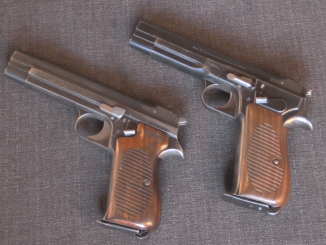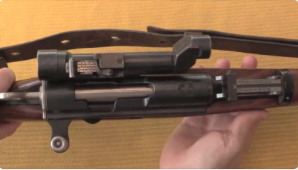Designed by Witold Chylewski, this was only the second pistol manufactured by SIG (the first being the 6.5mm blow-forward 1894 MAnnlicher design). It was patented prior to WW1, but only after the war was Chylewski able to find a manufacturer interested in his gun. The most notable element of the design is the use of a sliding trigger guard to allow the pistol to be cocked using the trigger finger, thus allowing carry with the chamber empty but still able to be drawn and fired one-handed. The pistol was chambered for .25 ACP (6.35mm Browning), and had a 7-round magazine.
SIG contracted to produce 1000 of them on license, but seems to have been unable to sell them all. Chylewski later took the patents to the Lignose company, where they formed the basis of a series of “Einhand” pistols in both .25 and .32 caliber, which were more successful (and as a result, more commonly found today).




Interesting little pistol. Let me help you with pronunciation of designer’s name: kh-i-l-e-v-s-k-i. Sorry but what I hear hurts my ears.
“SIG contracted to produce 1000 of them on license, but seems to have been unable to sell them all. ”
Unblinking Eye described SIG Chylewski in article Bergmann and Lignose
https://unblinkingeye.com/Guns/Lignose/lignose.html
states that the Chylewski einhandpistole (one-hand pistol) was produced in 1922 and 1923. There were problems with the design (it was all too easy to have the gun fire unintended when the cocker hit the trigger) and SIG quickly ended production and sold off the remaining stock. Many had their cockers disabled by the addition of a screw on the left side. The general consensus is that less than 1000 were made.
However what is quite mind-boggling for me is that they apparently sold them, despite they know about design flaw. Anyway independently from its shortcomings, taking in account production of other vest pocket automatic pistol in 1920s Switzerland it seems that demand for this kind of arms was low – around 2 other automatic pistols pattern were produced in time similar to SIG Chylewski in Switzerland namely
ARQUEBUSIER – see page 161: http://index-of.co.uk/Tutorials-2/Firearms%20Identification%20Volume%20I%20(2nd%20Edition%201973)%20By%20J%20Howard%20Mathews.pdf
Steyr-Solothurn, cal. 6,35 – see 52-4 here: http://www.earmi.it/armi/atlas/279.htm
First was produced in limited numbers, for second I was unable to retrieve such information, so even if SIG Chylewski would work correctly I suspect there was no big enough market in Switzerland for it.
Cocking spur both cocks and releases the slide and unintended discharge might occur when the user’s finger still at squezzed form provided with the slide at foremost position and disconnection disabled. lf the cocking spur were only cocker type, the gun might be more safe. lMHO…
“However what is quite mind-boggling for me is that they apparently sold them, despite they know about design flaw.”
Product warranty suits in the Twenties weren’t what they are today or Frank Bannerman would have spent his life either bankrupt, in jail or both. “Caveat Emptor” was the law of the land. And good luck if you’re a US citizen suing a Swiss Company, even today.
Interesting that back in the day, SIG went by their French name as Societe Industrielle Suisse. I wonder why they decided to go German? I would have thought that after WWI the French language would have been more politically acceptable.
Now SIG speaks American 🙂
Yeah, garbled American with apology words thrown in after the last “drop unsafe” accident spree.
Yes and No.
The original swiss SIG still exists and does what they have always done: making packaging machines of all kinds. Firemarms have always been a side business, hence why SAN SwissArms AG has been split off in 2000. The “SIG” in the USA has rights to the name being descended from the american importer and tehre is still sharing going on with the other SIG related firms like Sauer in Germany. But for all intents and purposes SIG (USA) is an american firm with american manufacturing, management, engineering, marketing.
Good info, thanks. I think mother plant in Switzerland gets crapload of competition by BT. If you look at latter company rifles, they are the way it should be, not overengineered, overprized exercises of futility.
If you read the Buffaloe article closely you will see that Chylewski’s second patent intended that the cocker also be able to fire the pistol — deliberately saving the time it took to shift the trigger finger back into the trigger guard. Of course this made it difficult to cock and not fire the pistol. C’s third patent dropped the feature so that the cocker was a cocker only. I hope Mr. M can show us a 9-shot Lignose with the brass cocker — that looks impressive.
Maybe the reason for the cock-and-shoot action was that muggers wouldn’t give you enough time to practice trigger-discipline while man-handling you in some dark alley!
Nicholas Wolfwood’s pistol in the Trigun anime imfdb.org
“(…)Chylewski’s second patent intended that the cocker also be able to fire the pistol(…)”
This explains why they sold remaining stock.
The German “Einhandpistole” variation of the Chylewski design was originally produced by Theodor Bergmann at Suhl. The first advertisement I am aware of was in the summer of 1921.
Only after Bergmann was bought by Lignose AG in early 1922, it became the Lignose Einhandpistole, first advertised in summer 1922.
Video shows that when the cocking spur drawn to rearmost place, the gun will already fired. This means the inventor initially thought to make a double action revolver type pistol with the chamber under the firing pin being empty but when the firing element activated it would go fired. Quite safe to carry and ready all the time to fire when needed. With a difference than a revolver, double action at first but single action at following shots provided with changing the trigger finger location. It seems, through the usage of other pistols of that age, the concept could not be understood and the cocking spur which beng a double action trigger in fact, was considered as a chamber loader only resulting unintentional discharges and from the information of other sources, it might be found out that, influencing the facts, both inventor and producer had changed the mission of cocking spur to be only as a chamber loader. IMHO.
In fact, a brilliant idea … Just beginning the development of auto loading pistols, a construction joining the advantages of both revolvers and autoloaders with a plus of flatness of the latter. Negative side might be the stiffness of double action trigger formed as a cocking spur or trigger guard. If it were understood correctly at the time, auto loading pistol development might be much different than all had.
How could mechanically that ever be achieved ? I think in practice it would not work, at least not reliable, also for a patent you do not need working specimen so he could wrote almost anything.
lt seems Mr. Chylewski had acchieved this. The pistol looks initially designed to be carried with a loaded magazine and empty chamber through the construction of enabling the user to fire the gun simply pulling the trigger guard to its rearmost location as; first loading the chamber and second, firing the fed round. This is of course only for the first shot and since the pistol being cocked and chamber loaded after that, the user should change the location of finger to the place of real trigger and continue to fire if needed.
Cocking and chamber loading might be made through a more easier mechanical manner say squezzing levers both at front or at rear of the frame handle or any other lay out might be thought if a manner of this application were commonly accepted.
By the way, patents should not be supported through working specimens but the text and drawings related, should describe their workability when examined by patent office staffs.
As seen in the video, the trigger guard was not thought and provided for cocking. lt was for quick shooting in an emergency… lf l were the inventor and producer, l would write it in the manual as a warning. “Use trigger guard cocking in an emergency…lt goes to absolute discharge”…
It seems obvious to me that the design was meant to fire when pulling the trigger guard fully to the rear. The pistol would then be ready for instant use much like a revolver. Boxes of the era usually had operating instruction printed on the inside of the lid. It would be interesting to read these instructions if they ever existed.
I want to propose to add new tag – EINHAND (I do not know single English word equivalent), which would be granted to any automatic pistol designed to provide effortless method of manual cycling with just one hand. Beyond SIG Chylewski these would be for example Praga 1921 https://www.forgottenweapons.com/ria-praga-1921-one-handed-pocket-pistol/ and JO.LO.AR.
Hope you played Playstation 1 and are familiar with its library of games 🙂
José López Arnaiz–Jo.Lo.Ar:
https://historiadelasarmasdefuego.blogspot.com/2008/12/pistola-joloar.html
The very, very expensive German TV miniseries _Babylon Berlin_ set in the Weimar-era has a Lignose Einhandpistole making an appearance:
http://www.imfdb.org/wiki/Babylon_Berlin_-_Season_1#Lignose_3A